Question bank
Chapter-1 Geographical Diversity of India
Q-1 Match the following
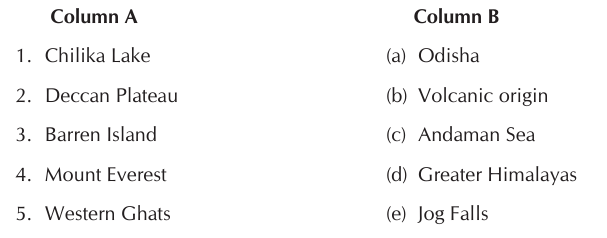
Q-2 True or False.
Q-3 Fill in the blanks.
Q-4 Answer the following questions in short.
Q-5 Answer the following questions in long.
Multiple Choice Questions
Q-1 Which region of India is referred to as 'Moonland' due to its barren, rocky terrain?
(i)
Thar desert(ii)
Ladakh(iii)
Aravalli hills(iv)
Peninsular plateauQ-2 The Khasi, Garo, and Jaintia Hills are part of ________.
(i)
Himalayas(ii)
Deccan plateau(iii)
Meghalaya plateau(iv)
Ladakh plateauQ-3 Which of the following is a characteristic feature of the Shivalik Hills?
(i)
Tallest peaks(ii)
Formed of loose sediments(iii)
Presence of glaciers(iv)
Active volcanoQ-4 Which river flows westward into the Arabian Sea?
(i)
Godavari(ii)
Krishna(iii)
Narmada(iv)
KaveriQ-5 What type of forests are found in the Sundarbans?
(i)
Alpine forests(ii)
Deciduous forests(iii)
Mangrove forests(iv)
Coniferous forestsQ-6 The Lakshadweep Islands are made up of:
(i)
Volcanic rocks(ii)
Granite hills(iii)
Coral atolls(iv)
River deltasQ-7 Which coastal feature is common on the eastern coast but not on the western coast of India?
(i)
Estuaries(ii)
Deltas(iii)
Cliffs(iv)
HarboursChapter-2 Exploring the Weather
Q-1
Match the following correctly :

Q-2 Fill in the blanks.
Q-3 Answer the following questions in short.
Q-4 Answer the following questions in long.
Q-5
Write True or False for each of the following statements.
1. The stratosphere is the layer where most weather events occur.
2. A thermometer measures wind speed.
3. High humidity makes the air feel cooler.
4. Ants moving their eggs can indicate upcoming rain.
5. The temperature increases with height in the mesosphere.
6. Rainfall is the only form of precipitation.
7. The mean daily temperature is calculated by averaging the maximum and minimum temperatures of the day.
Multiple Choice Questions
Q-1 What is the layer of the atmosphere where most weather events occur?
(i)
Stratosphere(ii)
Mesosphere(iii)
Thermosphere(iv)
Troposphere
Q-2 Which instrument measures atmospheric pressure?
(i)
Thermometer(ii)
Barometer
(iii)
Anemometer(iv)
HygrometerQ-3 What does a rain gauge measure?
(i)
Wind speed(ii)
Humidity(iii)
Rainfall
(iv)
TemperatureQ-4 Which of the following is NOT a form of precipitation?
(i)
Rain(ii)
Snow(iii)
Hail(iv)
Fog
Q-5 What is the standard atmospheric pressure at the sea level?
(i)
1013 millibars
(ii)
1000 millibars(iii)
980 millibars(iv)
1020 millibarsQ-6 Which instrument measures wind speed?
(i)
Anemometer
(ii)
Wind vane(iii)
Barometer(iv)
Rain gaugeQ-7 What is the term used for the average temperature of a day?
(i)
Temperature range(ii)
Maximum temperature(iii)
Minimum temperature(iv)
Mean daily temperature
Chapter-3 Understanding the Indian Climate
Q-1 Fill in the blanks.
Q-2
Match the terms in Column A with their descriptions in Column B
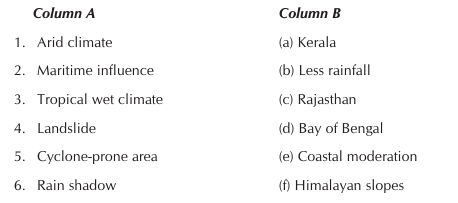
Q-3 True or False.
Q-4 Answer the following questions in short.
Q-5 Answer the following questions in long.
Q-6
Distinguish Between:
1. Weather and Climate
2. Southwest Monsoon and Northeast Monsoon
Multiple Choice Questions
Q-1 Which of the following is considered a long-term pattern of weather?
(i)
Rainfall on Monday(ii)
Weekly temperature report(iii)
Seasonal forecast(iv)
Climate
Q-2 Which region of India experiences an alpine climate?
(i)
Thar desert(ii)
Kerala coast(iii)
Himalayan region
(iv)
Northern plainsQ-3 From which language does the word 'monsoon' come?
(i)
Sanskrit(ii)
Persian
(iii)
Russian(iv)
LatinQ-4 Which of these is NOT a factor that influences climate?
(i)
Altitude(ii)
Ocean currents(iii)
Language
(iv)
LatitudeQ-5 Which type of climate is found in the Western Coastal region of India?
(i)
Arid(ii)
Temperate(iii)
Tropical Wet
(iv)
SubtropicalQ-6 Which disaster is caused due to the sudden movement of the earth on a slope?
(i)
Cyclone(ii)
Drought(iii)
Landslide
(iv)
EarthquakeQ-7 What is the calm area at the centre of a cyclone called?
(i)
Eye
(ii)
Core(iii)
Centre(iv)
VortexChapter-4 Cities and States: The Pillars of Early Political Life
Q-1 Fill in the blanks.
Q-2 True or False.
Q-3 Answer the following questions in short.
Q-4 Answer the following questions in long.
Q-5
Distinguish between.
1. Janapada and Mahājanapada
2. Varṇa and Jāti
Multiple Choice Questions
Q-1 What does the word 'janapada' literally mean?
(i)
The people’s assembly(ii)
The great kingdom(iii)
The city of warriors(iv)
The land where people have placed their feet
Q-2 Around which centuries BCE were the larger and more powerful janapadas formed?
(i)
10th–9th centuries BCE(ii)
8th–7th centuries BCE
(iii)
5th–4th centuries BCE(iv)
2nd–1st centuries BCEQ-3 Which of these was NOT a capital-city of a mahājanapada?
(i)
Varanasi(ii)
Rajgir(iii)
Ujjain(iv)
Delhi
Q-4 What were the assemblies called in early janapadas?
(i)
Sabha and Samiti
(ii)
Raja and Senapati(iii)
Gana and Sangha(iv)
Varna and JatiQ-5 Which mahājanapada was known for a more democratic form of governance?
(i)
Magadha(ii)
Vajjī
(iii)
Avanti(iv)
KosalaQ-6 What major technological advancement helped increase agricultural productivity during this period?
(i)
Bronze tools(ii)
Iron tools
(iii)
Copper tools(iv)
Stone toolsQ-7 What were the earliest coins in India called?
(i)
Gold coins(ii)
Silver coins(iii)
Punch-marked coins
(iv)
Copper coinsChapter-5 Understanding the Empires
Q-1 True or False.
Q-2 Answer the following questions in short.
Q-3 Answer the following questions in long.
Q-4
Match the two columns.
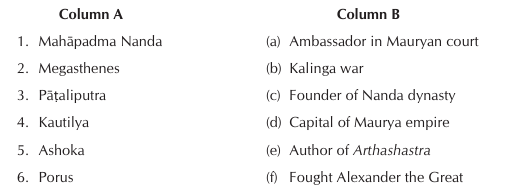
Q-5
Distinguish between:
1. A kingdom and an empire
Q-6 Fill in the blanks.
Multiple Choice Questions
Q-1 What was the capital of the Mauryan empire?
(i)
Ujjain(ii)
Taxila(iii)
Pāṭaliputra
(iv)
VaranasiQ-2 Who founded the Mauryan empire?
(i)
Ashoka(ii)
Kautilya(iii)
Chandragupta Maurya
(iv)
Mahāpadma NandaQ-3 The Arthashastra was written by:
(i)
Megasthenes(ii)
Kautilya
(iii)
Ajāṭashatru(iv)
PorusQ-4 In which language were Ashoka’s inscriptions mostly written?
(i)
Sanskrit(ii)
Pali(iii)
Prakrit
(iv)
GreekQ-5 Which battle changed Ashoka’s attitude towards war and violence?
(i)
Battle of Pāṭaliputra(ii)
Battle of Taxila(iii)
Kalinga War
(iv)
Battle of UjjainQ-6 The term ‘Samrāt’ in Sanskrit refers to:
(i)
King(ii)
Emperor
(iii)
Warrior(iv)
MerchantQ-7 Which dynasty introduced punch-marked coins?
(i)
Maurya
(ii)
Gupta(iii)
Nanda(iv)
MagadhaChapter-6 The Age of Reorganisation
Q-1 True or False
Q-2 Answer the following questions.
Q-3 Answer the following questions.
Q-4
Distinguish Between:
1. Gandhāra School and Mathurā School of Art
Q-5 Fill in the blanks.
Q-6
Match the following question:
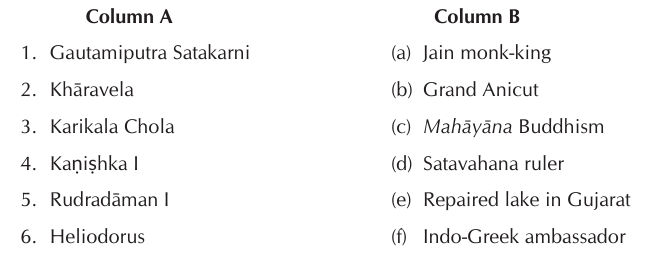
Multiple Choice Questions
Q-1 Who founded the Śunga dynasty?
(i)
Ashoka(ii)
Brihadratha(iii)
Pushyamitra Śunga
(iv)
VasudevaQ-2 Which dynasty is the Bharhut Stupa associated with?
(i)
Satavahana(ii)
Śunga
(iii)
Chola(iv)
KushanaQ-3 The capital-city of the Indo-Greek ruler Menander was:
(i)
Pataliputra(ii)
Sakala
(iii)
Amaravati(iv)
KarurQ-4 Who was the famous Satavahana queen known for land donations?
(i)
Nanegahat Queen
(ii)
Gautami Balashri(iii)
Devi(iv)
Prabhavati GuptaQ-5 What was the main source of Pandya trade revenue?
(i)
Spices(ii)
Pearls
(iii)
Cotton(iv)
TextilesQ-6 The Heliodorus Pillar was erected in honour of:
(i)
Shiva(ii)
Buddha(iii)
Vāsudeva
(iv)
LakshmiQ-7 The Grand Anicut built by Karikala Chola is used for:
(i)
Trade(ii)
Irrigation
(iii)
Navigation(iv)
DefenceChapter-7 Political Developments (Gupta Empire)
Q-1 True or False.
Q-2 Fill in the blanks.
Q-3 Answer the following questions.
Q-4 Answer the following questions.
Q-5
Match the following:

Multiple Choice Questions
Q-1 The period of the Gupta empire was between:
(i)
320–540 AD
(ii)
325–345 AD(iii)
300–380 AD(iv)
320–335 ADQ-2 The Allahabad Pillar inscription is related to:
(i)
Chandragupta I(ii)
Kerala coast(iii)
Himalayan region(iv)
Northern plains
Q-3 The founder of the Gupta dynasty was:
(i)
Chandragupta I
(ii)
Samudragupta(iii)
Skandagupta(iv)
KumaraguptaQ-4 Which Chinese traveller visited India in the Gupta period?
(i)
Fa-Hein
(ii)
Itsing(iii)
Huintsang(iv)
ItsangChapter-8 Sacred Land and Reverence
Q-1 Fill in the blanks.
Q-2 True or False
Q-3 Answer the following questions.
Q-4 Answer the following questions.
Q-5
Match the following:

Multiple Choice Questions
Q-1 The word ‘pilgrimage’ comes from a Latin word meaning—
(i)
Holy land(ii)
Spiritual peace(iii)
Traveller
(iv)
Temple worshipQ-2 The Great Stupa at Sanchi is located in:
(i)
Bihar(ii)
Uttar Pradesh(iii)
Madhya Pradesh
(iv)
GujaratQ-3 The Mahabodhi Stupa marks the spot where:
(i)
The Buddha was born(ii)
The Buddha gave his first sermon(iii)
The Buddha attained enlightenment
(iv)
The Buddha left for his last journeyQ-4 Sacred groves are important because they help to:
(i)
Build temples(ii)
Increase trade(iii)
Conserve biodiversity
(iv)
Dig wellsQ-5 The Chār Dhām Yātrā does not include —
(i)
Dwarka(ii)
Puri(iii)
Mecca
(iv)
RameswaramChapter-9 Understanding Government and Democracy
Q-1 Fill in the blanks.
Q-2 True or False
Q-3 Short Type Questions
Q-4 Long Type Questions
Q-5
Match the following:

Q-6
Distinguish between.
1. Democracy and Dictatorship.
2. Parliamentary and Presidential Democracy.
Multiple Choice Questions
Q-1 What is the main feature of a democratic government?
(i)
Power is inherited(ii)
Power is based on religion(iii)
Power is shared only by elites(iv)
Power lies with the people
Q-2 Which country follows a constitutional monarchy?
(i)
Saudi Arabia(ii)
Iran(iii)
United Kingdom
(iv)
North KoreaQ-3 In which form of government is power taken by force and held by one person?
(i)
Democracy(ii)
Theocracy(iii)
Dictatorship
(iv)
MonarchyQ-4 Who is responsible for making laws in a democracy?
(i)
Judiciary(ii)
Executive(iii)
Legislature
(iv)
MilitaryQ-5 Which of the following is a feature of direct democracy?
(i)
People elect representatives(ii)
King rules by divine right(iii)
People vote on every issue
(iv)
Power is held by religious leadersQ-6 What does ‘universal adult franchise’ mean?
(i)
Voting by landowners only(ii)
Voting by citizens above a certain income(iii)
Voting by students(iv)
Right to vote for all adult citizens
Q-7 Which type of democracy does India follow?
(i)
Parliamentary
(ii)
Theocratic(iii)
Presidential(iv)
DirectChapter-10 The Constitution of India – An Introduction
Q-1 Write True or False.
Q-2 Fill in the blanks.
Q-3 Answer the following questions in short.
Q-4 Answer the following questions in long.
Multiple Choice Questions
Q-1 What is a constitution primarily described as?
(i)
A set of historical stories(ii)
A written document laying down basic rules for governance
(iii)
A collection of poems(iv)
A guide for cooking recipes
Q-2 When did India's Constitution come into effect?
(i)
15th August 1947(ii)
26th January 1950
(iii)
2nd October 1869(iv)
14th November 1948
Q-3 Which of the following is NOT the main organ of the government as defined by the constitution?
(i)
Legislature(ii)
Executive(iii)
Judiciary(iv)
PressQ-4 Who was the President (Chairman) of the Constituent Assembly?
(i)
Dr. B.R. Ambedkar(ii)
Jawaharlal Nehru(iii)
Dr. Rajendra Prasad
(iv)
Sardar Vallabhbhai Patel
Q-5 From which country did the framers of the Indian Constitution take the idea of an independent judiciary and fundamental rights?
(i)
France(ii)
USA
(iii)
Ireland(iv)
United Kingdom
Q-6 What does ‘Universal Adult Franchise’ mean in the Indian Constitution?
(i)
Only educated adults can vote(ii)
Every citizen aged 18 or above has the right to vote
(iii)
Only men can vote(iv)
Voting rights are based on economic status
Q-7 What is the Preamble of the Constitution compared to?
(i)
A map(ii)
An introduction
(iii)
A dictionary(iv)
A novel
Chapter-11 The Journey of Trade: from Barter to Money
Q-1 Fill in the blanks.
Q-2 Write True or False.
Q-3 Answer the following questions in short.
Q-4 Answer the following questions in long.
Q-5
Distinguish between:
1. Barter System and Money-Based Trade.
2. Coins and Digital Money.
Multiple Choice Questions
Q-1 What is the main problem with the barter system?
(i)
Too many sellers(ii)
Double coincidence of wants
(iii)
No goods to exchange(iv)
Easy tradeQ-2 Which of these was not used for bartering in ancient times?
(i)
Rice(ii)
Seashells(iii)
Plastic
(iv)
GoatsQ-3 Who manages the printing and circulation of paper currency in India?
(i)
State Bank of India(ii)
Indian Government(iii)
Reserve Bank of India
(iv)
Ministry of FinanceQ-4 What is a major benefit of digital money?
(i)
It gets spoiled(ii)
It is hard to carry(iii)
It cannot be saved(iv)
It can be used for long-distance trade
Q-5 Which of these coins featured the image of Varaha, the boar avatar of Vishnu?
(i)
Maurya coins(ii)
Gupta coins
(iii)
Mughal coins(iv)
Chalukya coinsQ-6 UPI stands for:
(i)
United Payment India(ii)
Unified Payments Interface
(iii)
Unpaid Public Investment(iv)
Union Pay InternetQ-7 The first paper money was introduced in:
(i)
Egypt(ii)
China
(iii)
India(iv)
EuropeChapter-12 Understanding Markets
Q-1 Fill in the blanks.
Q-2 Write True or False.
Q-3 Answer the following questions in short.
d) Name the two types of physical markets.
Q-4 Answer the following questions in long.
Q-5
Match the following:
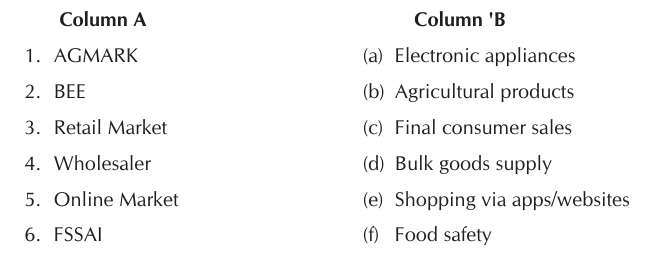
Multiple Choice Questions
Q-1 What is a market?
(i)
A bank(ii)
A place to study(iii)
A place to buy and sell goods
(iv)
A place to voteQ-2 Which of the following is a digital market?
(i)
Weekly haat(ii)
Shopping mall(iii)
Grocery store(iv)
Online shopping app
Q-3 The final agreed-upon price after bargaining is called:
(i)
Selling price(ii)
Maximum retail price(iii)
Market price
(iv)
Cost priceQ-4 Who does not usually sell directly to consumers?
(i)
Retailer(ii)
Wholesaler
(iii)
Shopkeeper(iv)
Online sellerQ-5 Which of these is a government-approved food safety mark?
(i)
AGMARK(ii)
ISI(iii)
FSSAI
(iv)
BEEQ-6 What does BEE Star Rating help as in knowing?
(i)
Energy efficiency
(ii)
Food safety(iii)
Product design(iv)
Price fixingQ-7 Which market deals in imports and exports?
(i)
Retail market(ii)
Domestic market(iii)
Wholesale market(iv)
International market